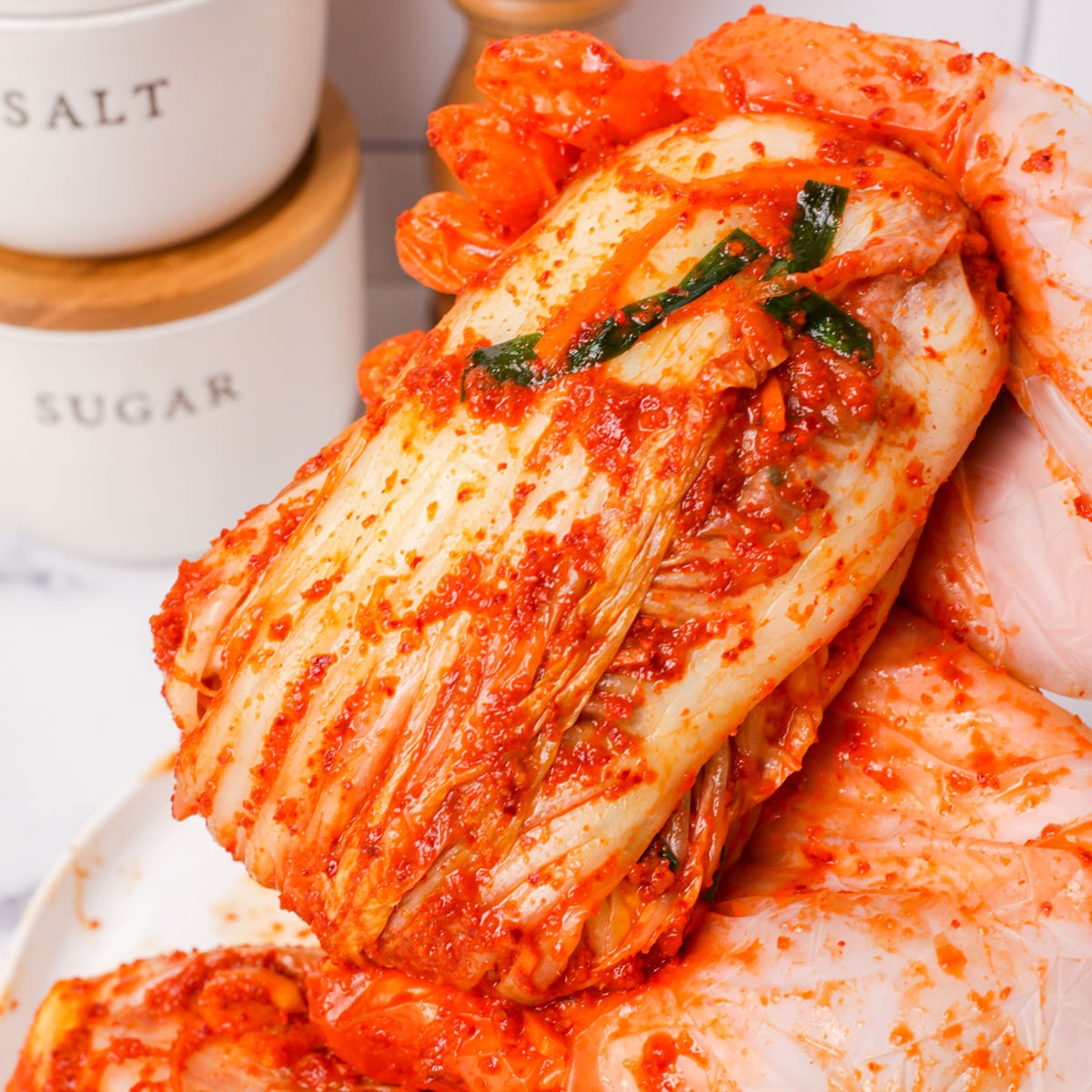Kimchi (Napa Cabbage Kimchi)
4.8
(8)
Your folders
Your folders
Prep Time: 195 minutes
Total: 135 minutes
Servings: 2

Ingredients
Export 11 ingredients for grocery delivery
Instructions
Step 1
Peel away and discard any undesirable outer layer leaves of the napa cabbage.
Step 2
With the napa cabbage laying on its side, quarter the cabbage long ways. You can also just cut the stem area of the cabbage and rip the rest of the cabbage open with your hand. Repeat with remaining napa cabbage.*Please refer to the post above for photo reference.*
Step 3
Trim away excess part of the cabbage core. Then, rinse and wash each quarter of the napa cabbage with water to remove dirt or grim. Make sure to pay extra attention to the outer few leaves. Drain the cabbages as best as you can.
Step 4
In a clean, sanitized area, salt each quarter of napa cabbage by sprinkling salt between each and every layer of leaves. Make sure to salt more generously around the stems. Repeat with all cabbages.
Step 5
Once all of the cabbages are salted, arrange and stack them in a large bowl. Cover and weigh down the cabbages with something heavy and let them salt for 1½ to 2 hours. Rotate the cabbages every 30 minutes, moving the ones on the top to the bottom.
Step 6
To check if the napa cabbage is done salting, rip off a small leaf of cabbage and rinse it with fresh water. Taste the cabbage. The cabbage will be very bendable and should taste well seasoned at the stem, while the leaf should be a littler saltier but not unbearable. If the cabbage does not taste salted enough, continue with the salting process for another 30 minutes to 1 hour, until the desired saltiness is achieved.
Step 7
While the napa cabbages are salting, make the kimchi paste. First, make the rice flour paste by whisking together the rice flour and water until well combined. Transfer the mixture to a pan or saucepan and cook over medium to medium high heat, stirring occasionally. Once the paste starts to thicken, stir constantly until the a thick, slightly translucent paste forms. Transfer to a large mixing bowl and let cool.
Step 8
In a blender, add the apple, onion, garlic cloves, ginger, and fish sauce. Blend everything together until the mixture is well blended. Add half of the gochugaru to the mix and blend until well combined and as smooth as possible.
Step 9
Transfer the mixture to the bowl with the cooled rice flour paste, along with the rest of the gochugaru. With gloved hands, mix the paste until well combined. Then, add the Korean radish, carrot, and Asian chives and mix well. Set aside until needed
Step 10
Once the napa cabbages are done salting, rinse the them with fresh water to remove excess salt. Make sure to get between each leaf. *We like to rinse our napa cabbage in a large bowl of water and repeating the process about 2 to 3 times with fresh water. We recommend tasting the cabbage after the final rinse to see if the cabbage require an additional round or two of rinsing.*
Step 11
After the final rinse, gently but firmly squeeze each quarter of napa cabbage to remove most of the excess water, especially the leaves are. But don’t squeeze too hard or the stems may get bruised and damaged.
Step 12
Working with gloved hands and one quarter of napa cabbage at one time, place the cabbage in the bowl of prepared kimchi marinade. Take some marinade and rub it on each leaf. Make sure to also leave some of the julienned veggies in between each layer too!
Step 13
Once the entire quarter of cabbage has been rubbed down with kimchi marinade, fold the cabbage over itself to keep it tight. Repeat with remaining cabbage.
Step 14
Pack the kimchi into sterilized glass jars or BPA free plastic kimchi containers. Make sure to pack the kimchi tightly into the container, but leave about at least 1 inch of space between the top of the kimchi and the lid. As the kimchi ferments, it will release juices and produce gas, so the extra room will help prevent the kimchi from overflowing.
Step 15
The napa cabbage kimchi can be enjoyed immediately after marinating, chilled, or you can let it ferment until it reaches your desired fermentation stage before eating or used in cooking. Feel free to cut the kimchi into smaller pieces when ready to enjoy.